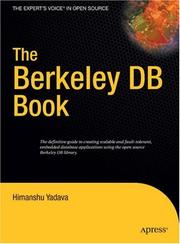| Listing 1 - 3 of 3 |
Sort by
|

ISBN: 1281139149 9786611139148 143020317X 1590596722 1430211954 Year: 2007 Publisher: Berkeley, Calif. : Apress,
Abstract | Keywords | Export | Availability | Bookmark
 Loading...
Loading...Choose an application
- Reference Manager
- EndNote
- RefWorks (Direct export to RefWorks)
The Berkeley DB Book is a practical guide to the intricacies of the Berkeley DB. This book covers in-depth the complex design issues that are mostly only touched on in terse footnotes within the dense Berkeley DB reference manual. It explains the technology at a higher level and also covers the internals, providing generous code and design examples. In this book, you will get to see a developer's perspective on intriguing design issues in Berkeley DB-based applications, and you will be able to choose design options for specific conditions. Also included is a special look at fault tolerance and high-availability frameworks. Berkeley DB is becoming the database of choice for large-scale applications like search engines and high-traffic web sites.
Computer science. --- Software engineering. --- Computer Science. --- Software Engineering/Programming and Operating Systems. --- Berkeley DB. --- Database management. --- Data base management --- Data services (Database management) --- Database management services --- DBMS (Computer science) --- Generalized data management systems --- Services, Database management --- Systems, Database management --- Systems, Generalized database management --- Electronic data processing --- Information Technology --- General and Others --- Database Management. --- Computer software engineering --- Engineering
Digital
ISBN: 9781430203179 Year: 2008 Publisher: Berkeley, CA Apress, Inc
Abstract | Keywords | Export | Availability | Bookmark
 Loading...
Loading...Choose an application
- Reference Manager
- EndNote
- RefWorks (Direct export to RefWorks)
Book
ISBN: 9781430203179 Year: 2008 Publisher: Berkeley, CA Apress, Inc.
Abstract | Keywords | Export | Availability | Bookmark
 Loading...
Loading...Choose an application
- Reference Manager
- EndNote
- RefWorks (Direct export to RefWorks)
The database technology landscape has been changing rapidly over the last few years. The server-based relational databases, which were so successful in solving the data-storage problem for traditional client/server and web-based applications, are no longer able to meet the requirements of newer applications, such as handheld devices, appliance-based solutions, and distributed applications. Berkeley DB is not a new technology that was designed to meet the requirements of this new breed of applications, but it is flexible enough to be used in these applications nevertheless. Berkeley DB doesn't fulfill all the requirements of these appli- tions, so new database technologies will evolve to fill the void. However, its versatility and flexibility will certainly influence the design of any new database product. This book's target audience ranges all the way from developers who don't know anything about Berkeley DB to fairly knowledgeable users. Therefore, I expect that not all readers will be interested in reading the entire book. I have given a brief outline of each chapter below to help you decide which chapters you may want to read or skip. Chapter 1: This chapter offers a general introduction to Berkeley DB. It includes a brief history of its development and a basic description of its architecture. If you're already familiar with Berkley DB, you can skip this chapter.
| Listing 1 - 3 of 3 |
Sort by
|

 Search
Search Feedback
Feedback About UniCat
About UniCat  Help
Help News
News